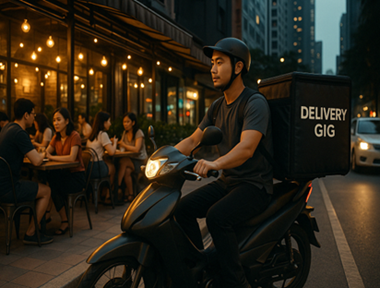Getting my kids to eat at hawker centres
Adj Assoc Prof and NBS Advisory Board member Abel Ang outlines a few tips to get his children accustomed to the hawker centre culture
It came as a shock that my kids, when they first returned to Singapore after living abroad, preferred dining in air-conditioned comfort instead
"Eww, gross," was how one of my boys described his first visit to a hawker centre after my family returned from the United States to Singapore more than a decade ago.
We had mostly dined out at fast-food and casual-dining restaurants in the US for the three years that we lived there.
Upon returning to Singapore, my kids sought out dining options they had grown familiar with in the US. These tended to be brightly lit, Western cuisine (preferably American) and, most importantly, air-conditioned.
Hawker centres - where metal spatulas clang and scrape, and rickety fans recirculate humid, oil-infused air laced with a hint of perspiration - were not a dining option my kids had exposure to in the US.
The smells, noise and heat were just too much for my little boys on their first visit. For them, eating at a hawker centre shortly after we landed on Singapore's shores was a shock to their senses. An experience not to be repeated.
Eating hot food in an open-air hawker centre is not comfortable. Period.
After that unpleasant experience, eating out as a family became increasingly fraught. The boys lobbied for dining venues they were accustomed to, but as parents, we wanted them to expand their range of dining options and food choices.
I wanted especially to expose them to the culinary treasures tucked away in hawker centres. The hawker centre has always been my preferred dining venue.
The dingier and more poorly ventilated the hawker centre, the better for keeping smells and flavours in the location.
The crammed and poorly ventilated Lau Pa Sat of old, before it was renovated in the mid-1980s, will always occupy a special place in my delicious food memories.
It is amazing how Singapore's humble open-air food centre has become a national institution and even made it onto Unesco's list of Intangible Cultural Heritage of Humanity icons.
As outlined on the National Environment Agency's website, hawker centres are "community dining rooms where friends and families gather, interact and bond over their shared love for food. They also serve as vibrant communal spaces that promote social cohesion, moderate the cost of living and foster a common national identity based on shared experiences, values and norms".
Singapore's hawker centres have been a source of pride for me in my many years overseas. Dining there is part of my special "return to Singapore ritual" and a quintessential part of my Singaporean identity.
After hearing my son's shocking comment, it dawned on me that I had mistakenly assumed that my kids, who at the time had spent more time away from Singapore than living here, would automatically share my pride and fondness for eating at hawker centres. I could not have been more wrong.
The innocent remark served as a wake-up call. I realised the situation would not change unless I took matters into my own hands.
As parents, we want to give our children the best of what we can offer, so it was difficult to keep insisting on eating at a location that my kids were clearly repelled by.
Why was it important to me that my boys be open to eating at hawker centres? Besides the venues being a part of the Singapore identity, they offer good value and plenty of choices, and are where much of Singapore's best-tasting food is found. To turn one's back on these advantages just because of a little discomfort was unthinkable for me.
Reflecting on what I did to turn my boys' eating habits around, there were four things that stood out:
1. STAY CALM
I tried hard not to react to the rejection of the hawker centre experience. I kept reminding myself how alien the eating environment came across to the boys, and that they were merely responding to that. Instead of losing my temper, I chose not to react to the comments they made, ignoring their mutterings during hawker centre meals.
2. STATE, NOT ASK
I would present the choice of where we would eat as a fait accompli. "Boys, we are going to eat at a hawker centre." It was a statement of where we were going, and not a request for their opinion or preference. This was difficult because my wife and I believe in giving the boys a chance to weigh in on their activities, clothes and other choices. The boys were given a choice to have milk and cereal at home if they did not like the setting, or perhaps wait outside the hawker centre while the rest of the family finished the meal.
3. STUBBORNNESS
It took a good dose of stubbornness to push through the hawker centre option, in the face of the children's opposition. I told myself we had to stay the course and keep persevering until the kids realised I was serious.
4. SETTLE SOMETIMES
Every so often I would give in, and we would eat at a location chosen by the boys.
This would happen once or twice a month, when I would accede to their request to eat at a restaurant or air-conditioned food court. During that visit, I would make it a point to reinforce that our family's default outside dining option is the hawker centre.
It has been many years since the "eww, gross" comment, and I asked my son about it recently. He no longer remembers it, but said candidly that if given a choice, he still prefers to eat at an air-conditioned food court or restaurant because he finds it more comfortable. In the same breath, he noted that the food quality and value are much better at hawker centres.
He summed it up by saying: For comfort, go with air-conditioning. For good food, go to a hawker centre.
Years later, we no longer have family disputes about where to eat. The boys are as comfortable at a hawker centre as in an air-conditioned dining environment.
I also know that when the boys are by themselves and need to have a meal outside, the humble hawker centre is a real option for them.
For me, that is more than what I could have hoped for.
Source: The Straits Times







